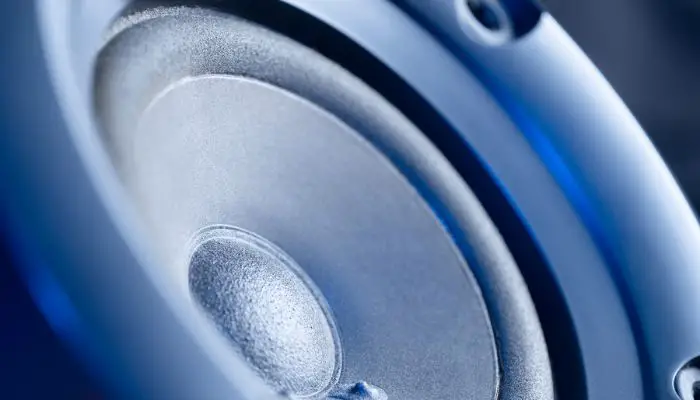A blown subwoofer is like one of those tiny gnats that keep flying around your face, trying to get in your nose or ear on an otherwise fine day. No matter how much you swat at it, you just can’t seem to deter the offending bug.
When your subwoofer cracks, it just kills the whole experience.
Since a good subwoofer is 50% of the entire music-listening experience, it can feel pretty rough when one goes down.
The bass that a good sub provides just adds that layer of depth and richness to everything. When it’s damaged, it can affect the entire listening experience.
So will a cracked subwoofer still work and can it be patched up to sound good again?
Table of Contents
Will a Cracked Subwoofer Still Work?

Unless you blow the thing apart or damage the voice coil, a subwoofer will keep working with a crack. It will just sound distorted every time the bass is deep. There’s a good chance that a small crack will become a big one if you don’t fix it or replace it soon.
A cracked subwoofer should either be repaired with epoxy (and silicone, if the rubber has split) or replaced as it will not sound right and the crack will end up spreading.
That low-intensity distortion will be enough to drive most people crazy anyway, so you will notice it quickly. If you’ve got that annoying trunk rattling going on, it may take a little longer to notice the immediate effect, especially if the initial crack is small.
If you happened to do some sort of damage to the voice coil, your sub is done and you may as well pack it up. A crack in the cone doesn’t signal the death knell but it’s annoying enough that you will probably want to fix it far more than you want to listen to it.
Either way, the audio distortion that you get from a cracked subwoofer will alert you to the problem immediately. If it’s a light issue, it will start with a buzzing, crackling sound. If it continues to get worse, the buzzing will intensify at specific decibels or it will stop working altogether.
What Causes a Subwoofer to Crack?
A crack or other damage to your subwoofer can be caused if it gets knocked around, is exposed to moisture, extreme temperatures, or just from prolonged use. A crack in a subwoofer may also be boiled down to two other possible things—RMS (Root Mean Square) and Peak Power Handling. The former is the maximum amount of power a sub can handle for an ongoing period.
The latter is how much power a sub can handle for brief moments in time. All subwoofers come with manuals or instructions informing you as to what these numbers are. It’s also likely that the manual will warn you not to exceed the limitations of the sub.
With that being said, the most common reason behind a cracked sub is excess RMS or Peak Power Handling. That’s not just a noise thing, in terms of decibels, but it’s also a wiring thing and is a pretty common problem when owners wire their auto sound system, allowing too much power in the sub.
Distorted signals often cause a sub to crack because, unbeknownst to the user, the distorted radio signal coming in might be pressing the range of the subwoofer. Because it’s distorted, the initial reaction is to turn it up and try to make sense of it. That’s when the sub cracks.
Is it Worth Fixing My Cracked Subwoofer?
It may be worth fixing a subwoofer. If it’s just a crack in the cone, that’s easy enough to seal with a strong epoxy or even some Gorilla Tape (or otherwise strong duct tape). Both will hold up just fine, though the bass quality may not be as intense as it once was.
Depending on how you received your subwoofer, there may even be a warranty on it, though it’s often difficult to file a successful warranty claim on a cracked subwoofer. The problem is, how is the manufacturer supposed to know if you didn’t void the warranty by cranking the decibels into the stratosphere?
It may be worth a shot, however, depending on how you approach the manufacturer. The third option is to simply replace it with a new sub. If there is more to it than a little epoxy or duct tape, you will probably discover that the repair is just as expensive, or more so than a replacement.
Overall, it’s really difficult to say without seeing the crack. There are several factors you should consider before you make the determination to fix it or toss it in favor of something new.
- Where is the location of the crack?
- How big is the crack?
- How strong is the level of distortion, buzzing, and crackling?
- What material is it?
- Is the basket causing the problem or is it the cone?
- Is the voice coil damaged? (a death sentence for the sub if it is)
Narrow things down. If you know enough about subwoofers, you will probably be able to make an informed decision based on what you see. The basket should never crack. If there is a crack in the basket, you should be able to take that up with the manufacturer.
If the crack is very narrow, even if it’s long, you should be able to fix it. You should avoid any kind of drilling or anything that will create metal dust or shards since the magnet will happily suck all of that stuff right in.
Related Article: Can A Subwoofer Break Glass? (Answered!)
How To Fix A Cracked Subwoofer So It Sounds Good Again
The crack is usually going to be located in the cone, which means you will have to pull the assembly out of its wood frame/box and access it from the back. Just because you can see the crack in the front doesn’t mean you should repair it from the front.
- Detach the wires
- Grab some 320 grit sandpaper
- Lightly sand around the crack (on the front side)
- Stick closely to the crack, without scuffing anything else
- Clean the sanded area
- Use Loctite Plastic Bonder
- Use rubber gloves
- Mix your epoxy on a piece of cardboard
- Cake the mixed epoxy onto the crack and rub it in smoothly and gently
- Flip the sub over and apply epoxy to the backside if accessible
- If not accessible, use a screwdriver to remove the basket
If any rubber has been ripped, you may also want to patch that up with a little black silicone.
That’s usually all there is to it. You should make sure that you rub it in nice and smooth and that the cracked halves aren’t separated from one another. You want the epoxy seal to hold the crack together as seamlessly as possible. Epoxy is just one option, however.
You can also use super glue, hot glue, silicone sealant, fiberglass cloth, or heavy-duty duct tape, though the duct tape option is best for placing on the backside of the crack.
When you apply the epoxy, you don’t need to pack it extra heavily. Just cake it on and use your gloved fingers to rub it in nice and smooth on the front and the back. Your only other option is to re-cone the speaker.
The problem with re-coning it is that you will essentially be replacing everything other than the box the speaker sits in. It kind of defeats the point as it will cost just as much or more than it would just to replace the speaker entirely.
How To Protect Your Subwoofer From Cracks
If you have a subwoofer at home as part of your living room setup, try not to place it anywhere where there is going to be a lot of footfall or where it can easily be kicked or knocked. Do a subwoofer crawl and try to find a spot for your sub that’s out of the way but still also sounds good. And If you are transporting your subwoofer, don’t just leave it in the boot of the car to roll around, try to secure it in place first.
Most subwoofers are designed for a rugged lifestyle, especially in the auto industry. Bumps in the road, slamming on the brakes, and cranking the volume up are just part of it. That doesn’t mean that your sub is unbreakable.
One thing that consumers like to do is install a “grill” around the subwoofer in the car. The grill not only protects the sub from moving around wherever it is in the vehicle, but it also keeps other items in the vehicle from slamming into the sub.
Another thing that you need to do, especially if you are installing a system in your home or in your car on your own, is to make sure that the wiring you use matches the specs for the sub and the other speakers in the system.
We discussed what happens when you push too much power to the sub. Keep additional speaker wires away from the sub. The interior magnet is pretty powerful and you need to keep any metal away from it. So you probably shouldn’t toss your tire iron in there next to the sub.
If you are experiencing distortion on a radio station, don’t crank the volume up to make sense of it. Distortion is often at a frequency your ears can’t decipher and it might put undue strain on the sub.
Other electronic devices may run interference with your sub as well and if it’s messing with the sub, it’s going to mess with everything else as well. No, your smartphone is probably not the culprit. Just be sure that no other electronic equipment is placed near your speakers or wiring.
Most of what causes problems with subs or the other speakers in your home theater or auto setup are minor things. Just keep on top of them and ensure that you install everything correctly and up to the product’s specs.
Bottom Line
There are an unfortunately wide number of issues that can cause your sub to crack. The truth is, 90% of the time you’re going to be better off just replacing the sub rather than repairing it. If it’s a simple fix that nothing more than a little epoxy glue can handle, go for it.
If not, replacing the sub is your best option.



